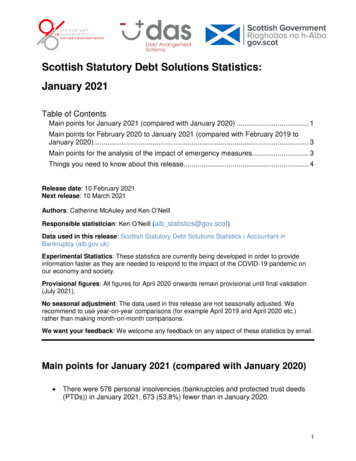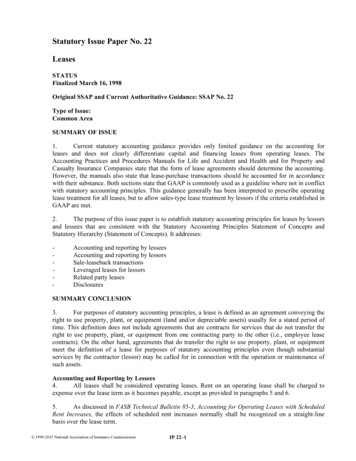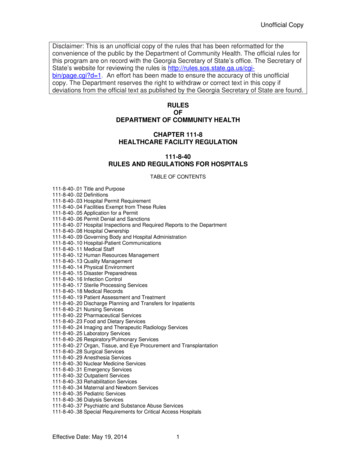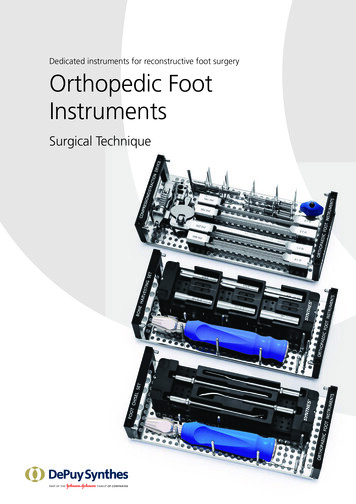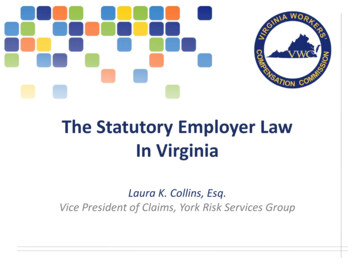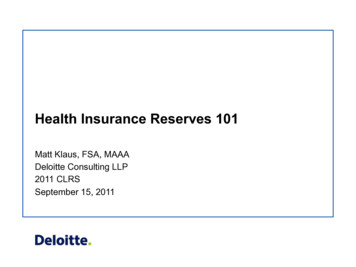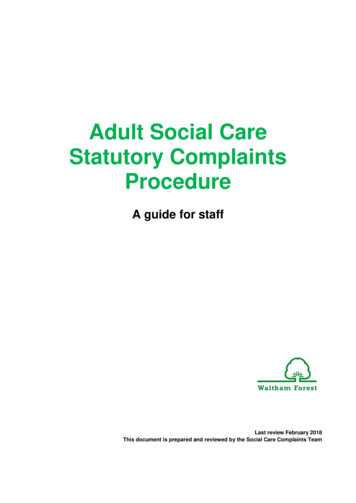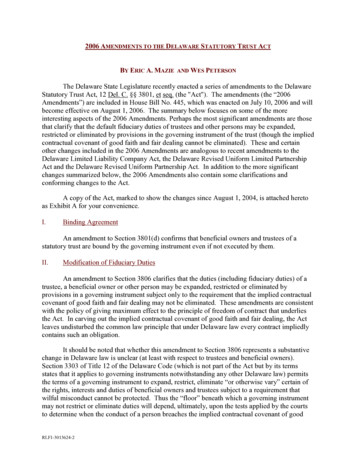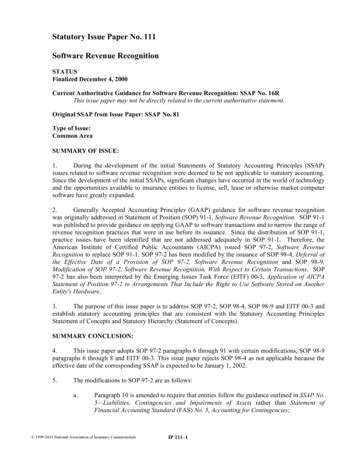
Transcription
Statutory Issue Paper No. 111Software Revenue RecognitionSTATUSFinalized December 4, 2000Current Authoritative Guidance for Software Revenue Recognition: SSAP No. 16RThis issue paper may not be directly related to the current authoritative statement.Original SSAP from Issue Paper: SSAP No. 81Type of Issue:Common AreaSUMMARY OF ISSUE:1.During the development of the initial Statements of Statutory Accounting Principles (SSAP)issues related to software revenue recognition were deemed to be not applicable to statutory accounting.Since the development of the initial SSAPs, significant changes have occurred in the world of technologyand the opportunities available to insurance entities to license, sell, lease or otherwise market computersoftware have greatly expanded.2.Generally Accepted Accounting Principles (GAAP) guidance for software revenue recognitionwas originally addressed in Statement of Position (SOP) 91-1, Software Revenue Recognition. SOP 91-1was published to provide guidance on applying GAAP to software transactions and to narrow the range ofrevenue recognition practices that were in use before its issuance. Since the distribution of SOP 91-1,practice issues have been identified that are not addressed adequately in SOP 91-1. Therefore, theAmerican Institute of Certified Public Accountants (AICPA) issued SOP 97-2, Software RevenueRecognition to replace SOP 91-1. SOP 97-2 has been modified by the issuance of SOP 98-4, Deferral ofthe Effective Date of a Provision of SOP 97-2, Software Revenue Recognition and SOP 98-9,Modification of SOP 97-2, Software Revenue Recognition, With Respect to Certain Transactions. SOP97-2 has also been interpreted by the Emerging Issues Task Force (EITF) 00-3, Application of AICPAStatement of Position 97-2 to Arrangements That Include the Right to Use Software Stored on AnotherEntity's Hardware.3.The purpose of this issue paper is to address SOP 97-2, SOP 98-4, SOP 98-9 and EITF 00-3 andestablish statutory accounting principles that are consistent with the Statutory Accounting PrinciplesStatement of Concepts and Statutory Hierarchy (Statement of Concepts).SUMMARY CONCLUSION:4.This issue paper adopts SOP 97-2 paragraphs 6 through 91 with certain modifications, SOP 98-9paragraphs 6 through 8 and EITF 00-3. This issue paper rejects SOP 98-4 as not applicable because theeffective date of the corresponding SSAP is expected to be January 1, 2002.5.The modifications to SOP 97-2 are as follows:a.Paragraph 10 is amended to require that entities follow the guidance outlined in SSAP No.5—Liabilities, Contingencies and Impairments of Assets rather than Statement ofFinancial Accounting Standard (FAS) No. 5, Accounting for Contingencies; 1999-2015 National Association of Insurance CommissionersIP 111–1
IP No. 111Issue Paperb.Paragraph 33 is amended to remove the reference to Technical Bulletin (TB) No. 79-10:Fiscal Funding Clauses in Lease Agreements;c.Paragraph 57 is amended to remove the reference to FAS No. 86, Accounting for theCosts of Computer Software to Be Sold, Leased, or Otherwise Marketed;d.Paragraph 73 is rejected as not applicable to statutory accounting.Effective Date and Transition6.Upon adoption of this issue paper, the NAIC will release a Statement of Statutory AccountingPrinciple (SSAP) for comment. The SSAP will contain the adopted Summary Conclusion of this issuepaper. Users of the Accounting Practices and Procedures Manual should note that issue papers are notrepresented in the Statutory Hierarchy (see Section IV of the Preamble) and therefore the conclusionsreached in this issue paper should not be applied until the corresponding SSAP has been adopted by thePlenary of the NAIC. It is expected that the SSAP will contain an effective date of years beginning on orafter January 1, 2002.DISCUSSION:7.The modifications to SOP 97-2 were made in order to maintain consistency with current statutoryaccounting principles and the Statement of Concepts.a.Paragraph 10 is amended because it includes a reference to FAS No. 5, Accounting forContingencies. SSAP No. 5—Liabilities, Contingencies and Impairments of Assetscontains the authoritative statutory accounting for loss contingencies;b.Paragraph 33 is amended because it includes a reference to TB No. 79-10. The removalof the reference does not change the accounting prescribed in SOP 97-2 and it eliminatesany possible conflict with the fact that TB No. 79-10 is rejected by SSAP No. 22 —Leases;c.Paragraph 57 was amended because it includes a reference to FAS No. 86. Paragraph 57is not impacted by the removal of FAS No. 86 because it is used in the context of a pieceof historical evidence. SSAP No. 17 - Preoperating and Research and DevelopmentCosts requires all such costs to be expensed, therefore there is no capitalizationexperience to analyze;d.Paragraph 73 was deemed to be not applicable because of the requirement to follow FASNo. 86 in the case of capitalizing funded software-development costs. This approach isinconsistent with the provisions of SSAP No. 17 and the requirement to expense suchcosts. The directive to expense such costs eliminates the need for this paragraph.8.SOP 98-4 as well as the effective date paragraphs of SOP 97-2 and SOP 98-9 were not adopted inthis issue paper as it is expected that the effective date for the SSAP will be January 1, 2002.9.EITF 00-3 was adopted because it supports the principles adopted in SOP 97-2.10.SOP 97-2 includes several references to GAAP pronouncements that were deemed not applicablein the initial SSAPs. This includes Accounting Research Bulletin No. 45, Long-Term Construction-TypeContracts, SOP 81-1, Accounting for Performance of Construction-Type and Certain Production-TypeContracts, FAS No. 48, Revenue Recognition When Right of Return Exists and FAS 68, Research and 1999-2015 National Association of Insurance CommissionersIP 111–2
Software Revenue RecognitionIP No. 111Development Arrangements. These GAAP pronouncements are deemed to be applicable to statutoryaccounting only to the extent that SOP 97-2 references them.RELEVANT STATUTORY ACCOUNTING AND GAAP GUIDANCE:Statutory Accounting11.In general, the initial SSAPs deemed the relevant GAAP guidance to be not applicable tostatutory accounting. As discussed above, technology and the environment have changed significantlysince the original SSAPs were adopted and therefore guidance is now needed.Generally Accepted Accounting Principles12.AICPA Statement of Position 97-2, Software Revenue Recognition provides the following:Conclusions.06The following conclusions should be read in conjunction with the Basis for Conclusionssection, beginning with paragraph .93 of this SOP, and the examples in appendix A, Examples ofthe Application of Certain Provisions of this SOP.Basic Principles.07Software arrangements range from those that provide a license for a single softwareproduct to those that, in addition to the delivery of software or a software system, requiresignificant production, modification, or customization of software. If an arrangement to deliversoftware or a software system, either alone or together with other products or services, requiressignificant production, modification, or customization of software, the entire arrangement shouldbe accounted for in conformity with Accounting Research Bulletin (ARB) No. 45, Long-TermConstruction-Type Contracts, using the relevant guidance herein, and in SOP 81-1, Accountingfor Performance of Construction-Type and Certain Production-Type Contracts.08If the arrangement does not require significant production, modification, or customizationof software, revenue should be recognized when all of the following criteria are met. Persuasive evidence of an arrangement exists. Delivery has occurred. The vendor’s fee is fixed or determinable. Collectibility is probable.09Software arrangements may provide licenses for multiple software deliverables (forexample, software products, upgrades/enhancements, PCS, or services), which are termedmultiple elements. A number of the elements may be described in the arrangement as beingdeliverable only on a when-and-if-available basis. When-and-if-available deliverables should beconsidered in determining whether an arrangement includes multiple elements. Accordingly, therequirements of this SOP with respect to arrangements that consist of multiple elements shouldbe applied to all additional products and services specified in the arrangement, including thosedescribed as being deliverable only on a when-and-if-available basis.10If an arrangement includes multiple elements, the fee should be allocated to the variouselements based on vendor-specific objective evidence of fair value, regardless of any separateprices stated within the contract for each element. Vendor-specific objective evidence of fairvalue is limited to the following: The price charged when the same element is sold separately For an element not yet being sold separately, the price established bymanagement having the relevant authority; it must be probable that the price,once established, will not change before the separate introduction of the elementinto the marketplaceThe amount allocated to undelivered elements is not subject to later adjustment. However, if itbecomes probable that the amount allocated to an undelivered element will result in a loss on 1999-2015 National Association of Insurance CommissionersIP 111–3
IP No. 111Issue Paperthat element of the arrangement, the loss should be recognized pursuant to FASB Statement No.5, Accounting for Contingencies. When a vendor’s pricing is based on multiple factors such asthe number of products and the number of users, the amount allocated to the same elementwhen sold separately must consider all the factors of the vendor’s pricing structure.11If a discount is offered in a multiple-element arrangement, a proportionate amount of thatdiscount should be applied to each element included in the arrangement based on eachelement’s fair value without regard to the discount. However, as discussed in paragraph .37, noportion of the discount should be allocated to any upgrade rights. Moreover, to the extent that adiscount exists, the residual method described in paragraph .12 attributes that discount entirely tothe delivered elements.12If sufficient vendor-specific objective evidence does not exist for the allocation of revenueto the various elements of the arrangement, all revenue from the arrangement should be deferreduntil the earlier of the point at which (a) such sufficient vendor-specific objective evidence doesexist or (b) all elements of the arrangement have been delivered. The following exceptions to thisguidance are provided. If the only undelivered element is PCS, the entire fee should be recognizedratably (see paragraphs .56 through .62). If the only undelivered element is services that do not involve significantproduction, modification, or customization of software (for example, training orinstallation), the entire fee should be recognized over the period during which theservices are expected to be performed (see paragraphs .63 through .71). If the arrangement is in substance a subscription, the entire fee should berecognized ratably (see paragraphs .48 and .49). If the fee is based on the number of copies, the arrangement should beaccounted for in conformity with paragraphs .43 through .47. There may be instances in which there is vendor-specific objective evidence ofthe fair values of all undelivered elements in an arrangement but vendor-specificobjective evidence of fair value does not exist for one or more of the deliveredelements in the arrangement. In such instances, the fee should be recognizedusing the residual method, provided that (a) all other applicable revenuerecognition criteria in this SOP are met and (b) the fair value of all of theundelivered elements is less than the arrangement fee. Under the residualmethod, the arrangement fee is recognized as follows: (a) the total fair value ofthe undelivered elements, as indicated by vendor-specific objective evidence, isdeferred and (b) the difference between the total arrangement fee and theamount deferred for the undelivered elements is recognized as revenue relatedto the delivered elements.13The portion of the fee allocated to an element should be recognized as revenue when thecriteria in paragraph .08 of this SOP are met with respect to the element. In applying thosecriteria, the delivery of an element is considered not to have occurred if there are undeliveredelements that are essential to the functionality of the delivered element, because the customerwould not have the full use of the delivered element.14No portion of the fee (including amounts otherwise allocated to delivered elements)meets the criterion of collectibility if the portion of the fee allocable to delivered elements issubject to forfeiture, refund, or other concession if any of the undelivered elements are notdelivered. In order for the revenue related to an arrangement to be considered not subject toforfeiture, refund, or other concession, management must intend not to provide refunds orconcessions that are not required under the provisions of the arrangement. All availableevidence should be considered to determine whether the evidence persuasively indicates that therevenue is not subject to forfeiture, refund, or other concession. Although no single item ofevidence may be persuasive, the following additional items should be considered: Acknowledgment in the arrangement of products not currently available or not tobe delivered currently Separate prices stipulated in the arrangement for each deliverable element 1999-2015 National Association of Insurance CommissionersIP 111–4
Software Revenue RecognitionIP No. 111 Default and damage provisions as defined in the arrangementEnforceable payment obligations and due dates for the delivered elements thatare not dependent on the delivery of the future deliverable elements, coupledwith the intent of the vendor to enforce rights of payment Installation and use of the delivered software Support services, such as telephone support, related to the delivered softwarebeing provided currently by the vendorRegardless of the preceding, the vendor’s historical pattern of making refunds or otherconcessions that were not required under the original provisions (contractual or other) of otherarrangements should be considered more persuasive than terms included in the arrangementthat indicate that no concessions are required.Evidence of an Arrangement.15Practice varies with respect to the use of written contracts. Although a number of sectorsof the industry rely upon signed contracts to document arrangements, other sectors of theindustry that license software (notably the packaged software sector) do not.16If the vendor operates in a manner that does not rely on signed contracts to documentthe elements and obligations of an arrangement, the vendor should have other forms of evidenceto document the transaction (for example, a purchase order from a third party or on-lineauthorization). If the vendor has a customary business practice of utilizing written contracts,evidence of the arrangement is provided only by a contract signed by both parties.17Even if all other requirements set forth in this SOP for the recognition of revenue are met(including delivery), revenue should not be recognized on any element of the arrangement unlesspersuasive evidence of an arrangement exists.Delivery.18The second criterion in paragraph .08 for revenue recognition is delivery. The principleof not recognizing revenue before delivery applies whether the customer is a user or a reseller.Except for arrangements in which the fee is a function of the number of copies, delivery isconsidered to have occurred upon the transfer of the product master or, if the product master isnot to be delivered, upon the transfer of the first copy. For software that is deliveredelectronically, the delivery criterion of paragraph .08 is considered to have been met when thecustomer either (a) takes possession of the software via a download (that is, when the customertakes possession of the electronic data on its hardware), or (b) has been provided with accesscodes that allow the customer to take immediate possession of the software on its hardwarepursuant to an agreement or purchase order for the software. In such cases, revenue should berecognized if the other criteria of paragraph .08 have been satisfied.19Paragraphs .20 through .25 provide guidance on determining whether delivery isconsidered to have occurred in certain kinds of software transactions.Customer Acceptance.20After delivery, if uncertainty exists about customer acceptance of the software, licenserevenue should not be recognized until acceptance occurs.Determining Delivery—Multiple Copies of Software Products Versus Multiple Licenses.21Arrangements to use multiple copies of a software product under site licenses with usersand to market multiple copies of a software product under similar arrangements with resellersshould be distinguished from arrangements to use or market multiple single licenses of the samesoftware. In the former kind of arrangement, duplication is incidental to the arrangementand the delivery criterion is met upon the delivery of the first copy or product 1999-2015 National Association of Insurance CommissionersIP 111–5
IP No. 111Issue Paper master. The vendor may be obligated to furnish up to a specified number ofcopies of the software, but only if the copies are requested by the user. Thelicensing fee is payable even if no additional copies are requested by the user orreseller.If the other criteria in this SOP for revenue recognition are met,revenue should be recognized upon delivery of the first copy or product master.The estimated costs of duplication should be accrued at that time.In the latter kind of arrangement, the licensing fee is a function of the number ofcopies delivered to, made by, or deployed by the user or reseller. Deliveryoccurs and revenue should be recognized as the copies are made by the user orsold by the reseller if the other criteria in this SOP for revenue recognition aremet.Delivery Other Than to the Customer.22Delivery should not be considered complete unless the destination to which the softwareis shipped is the customer’s place of business or another site specified by the customer. Inaddition, if a customer specifies an intermediate site but a substantial portion of the fee is notpayable until the delivery by the vendor to another site specified by the customer, revenue shouldnot be recognized until the delivery is made to that other site.Delivery Agents.23Vendors may engage agents, often referred to as fulfillment houses, to either duplicateand deliver or only deliver software products to customers. Revenue from transactions involvingdelivery agents should be recognized when the software is delivered to the customer.Transferring the fulfillment obligation to an agent of the vendor does not relieve the vendor of theresponsibility for delivery. This is the case even if the vendor has no direct involvement in theactual delivery of the software product to the customer.Authorization Codes.24In a number of software arrangements, vendors use authorization codes, commonlyreferred to as keys, to permit customer access to software that otherwise would be restricted.Keys are used in a variety of ways and may serve different purposes. For example, permanentkeys may be used to control access to the software, or additional permanent keys may benecessary for the duplication of the software. Temporary keys may be used for the samepurposes and also may be used to enhance the vendor's ability to collect payment or to controlthe use of software for demonstration purposes.25In software arrangements involving the use of keys, delivery of a key is not necessarilyrequired to satisfy the vendor’s delivery responsibility. The software vendor should recognizerevenue on delivery of the software if all other requirements for revenue recognition under thisSOP and all of the following conditions are met. The customer has licensed the software and the vendor has delivered a versionof the software that is fully functional except for the permanent key or theadditional keys (if additional keys are used to control the reproduction of thesoftware). The customer's obligation to pay for the software and the terms of payment,including the timing of payment, are not contingent on delivery of the permanentkey or additional keys (if additional keys are used to control the reproduction ofthe software). The vendor will enforce and does not have a history of failing to enforce its rightto collect payment under the terms of the original arrangement.In addition, if a temporary key is used to enhance the vendor's ability to collect payment, thedelivery of additional keys, whether temporary or permanent, is not required to satisfy thevendor’s delivery responsibility if (a) the above conditions are met and (b) the use of a temporarykey in such circumstances is a customary practice of the vendor. Selective issuance of 1999-2015 National Association of Insurance CommissionersIP 111–6
Software Revenue RecognitionIP No. 111temporary keys might indicate that collectibility is not probable or that the software is being usedonly for demonstration purposes.Fixed or Determinable Fees and Collectibility.26The other prerequisites in paragraph .08 for revenue recognition are that (a) the vendor’sfee is fixed or determinable and (b) collectibility is probable. A software licensing fee is not fixedor determinable if the amount is based on the number of units distributed or copied, or theexpected number of users of the product. Revenue recognition for variable-pricing arrangementsis discussed in paragraphs .43 through .47 of this SOP. Additionally, if an arrangement includes(a) rights of return or (b) rights to refunds without return of the software, FASB Statement No. 48requires that conditions that must be met in order for the vendor to recognize revenue includethat the amount of future returns or refunds can be reasonably estimated.Factors That Affect the Determination of Whether a Fee is Fixed or Determinable and Collectible.27A number of arrangements that call for fixed or determinable payments, includingminimum royalties or license fees from resellers, specify a payment period that is short in relationto the period during which the customer is expected to use or market the related products. Otherarrangements have payment terms that extend over a substantial portion of the period duringwhich the customer is expected to use or market the related products. Because a product’scontinuing value may be reduced due to the subsequent introduction of enhanced products bythe vendor or its competitors, the possibility that the vendor still may provide a refund orconcession to a creditworthy customer to liquidate outstanding amounts due under the originalterms of the arrangement increases as payment terms become longer.28For the reason cited in paragraph .27 any extended payment terms in a softwarelicensing arrangement may indicate that the fee is not fixed or determinable. Further, if paymentof a significant portion of the software licensing fee is not due until after expiration of the licenseor more than twelve months after delivery, the licensing fee should be presumed not to be fixedor determinable. However, this presumption may be overcome by evidence that the vendor hasa standard business practice of using long-term or installment contracts and a history ofsuccessfully collecting under the original payment terms without making concessions. In such asituation, a vendor should consider such fees fixed or determinable and should recognizerevenue upon delivery of the software, provided all other conditions for revenue recognition in thisSOP have been satisfied.29If it cannot be concluded that a fee is fixed or determinable at the outset of anarrangement, revenue should be recognized as payments from customers become due(assuming all other conditions for revenue recognition in this SOP have been satisfied).30For reseller arrangements, the following factors also should be considered in evaluatingwhether the fixed or determinable fee and collectibility criteria for revenue recognition are met. Business practices, the reseller's operating history, competitive pressures,informal communications, or other factors indicate that payment is substantiallycontingent on the reseller's success in distributing individual units of the product. Resellers are new, undercapitalized, or in financial difficulty and may notdemonstrate an ability to honor a commitment to make fixed or determinablepayments until they collect cash from their customers. Uncertainties about the potential number of copies to be sold by the reseller mayindicate that the amount of future returns cannot be reasonably estimated ondelivery; examples of such factors include the newness of the product ormarketing channel, competitive products, or dependence on the market potentialof another product offered (or anticipated to be offered) by the reseller. Distribution arrangements with resellers require the vendor to rebate or credit aportion of the original fee if the vendor subsequently reduces its price for aproduct and the reseller still has rights with respect to that product (sometimesreferred to as price protection). If a vendor is unable to reasonably estimate 1999-2015 National Association of Insurance CommissionersIP 111–7
IP No. 111Issue Paperfuture price changes in light of competitive conditions, or if significantuncertainties exist about the vendor’s ability to maintain its price, thearrangement fee is not fixed or determinable. In such circumstances, revenuefrom the arrangement should be deferred until the vendor is able to reasonablyestimate the effects of future price changes and the other conditions of this SOPhave been satisfied.31Customer Cancellation Privileges. Fees from licenses cancelable by customers areneither fixed nor determinable until the cancellation privileges lapse. Fees from licenses withcancellation privileges expiring ratably over the license period are considered to becomedeterminable ratably over the license period as the cancellation privileges lapse. In applying theprovisions of this paragraph, obligations related to warranties for defective software, includingwarranties that are routine, short-term, and relatively minor, should be accounted for inconformity with FASB Statement No. 5. Additionally, short-term rights of return, such as thirtyday money-back guarantees, should not be considered cancellation privileges; the related returnsshould be accounted for in conformity with FASB Statement No. 48.32Fiscal Funding Clauses. Fiscal funding clauses sometimes are found in software licensearrangements in which the licensees are governmental units. Such clauses generally providethat the license is cancelable if the legislature or funding authority does not appropriate the fundsnecessary for the governmental unit to fulfill its obligations under the licensing arrangement.33Consistent with FASB Technical Bulletin No. 79-10, Fiscal Funding Clauses in LeaseAgreements, a software licensing arrangement with a governmental unit containing a fiscalfunding clause should be evaluated to determine whether the uncertainty of a possible licensearrangement cancellation is a remote contingency. If the likelihood is assessed as remote, thesoftware licensing arrangement should be considered noncancelable. Such an assessmentshould include the factors discussed in paragraphs .27 and .28 of this SOP. If the likelihood isassessed as other than remote, the license should be considered cancelable, thus precludingrevenue recognition. A fiscal funding clause with a customer other than a governmental unit thatis required to include such a clause creates a contingency that precludes revenue recognitionuntil the requirements of the clause and all other provisions of this SOP have been satisfied.Multiple-Element Arrangements.34As discussed in paragraph .09, multiple-element arrangements to which contractaccounting does not apply may include customer rights to any combination of additional softwaredeliverables, services, or PCS. If contract accounting does not apply, individual elements in sucharrangements should be accounted for in accordance with paragraphs .08 through .14.Paragraphs .35 through .73 provide guidance on the application of those paragraphs to multipleelement arrangements.Additional Software Deliverables and Rights to Exchange or Return Software.35As part of a multiple-element arrangement, a vendor may agree to deliver softwarecurrently and to deliver additional software in the future. The additional deliverables may includeupgrades/enhancements or additional software products. Additionally, a vendor may provide thecustomer with the right to exchange or return software, including the right to transfer softwarefrom one hardware platform or operating system to one or more other platforms or operatingsystems (a platform-transfer right).36Upgrades/enhancements. As part of a multiple-element arrangement, a vendor mayagree to deliver software currently and provide the customer with an upgrade right for a specifiedupgrade/enhancement. The upgrade right may be evidenced by a specific agreement,commitment, or the vendor's established practice.(Rights to receive unspecifiedupgrades/enhancements on a when-and-if-available basis are PCS, as it has been redefined inthis SOP.) The upgrade right should be accounted for as a separate element in accordance with 1999-2015 National Association of Insurance CommissionersIP 111–8
Software Revenue RecognitionIP No. 111paragraphs .08 through .14. Guidance on the application of those paragraphs to multipleelement software arrangements that include upgrad
Recognition to replace SOP 91-1. SOP 97-2 has been modified by the issuance of SOP 98-4, Deferral of the Effective Date of a Provision of SOP 97-2, Software Revenue Recognition and SOP 98-9, Modification of SOP 97-2, Software Revenue Recognition, With Respect to Certain Transactions. SOP
